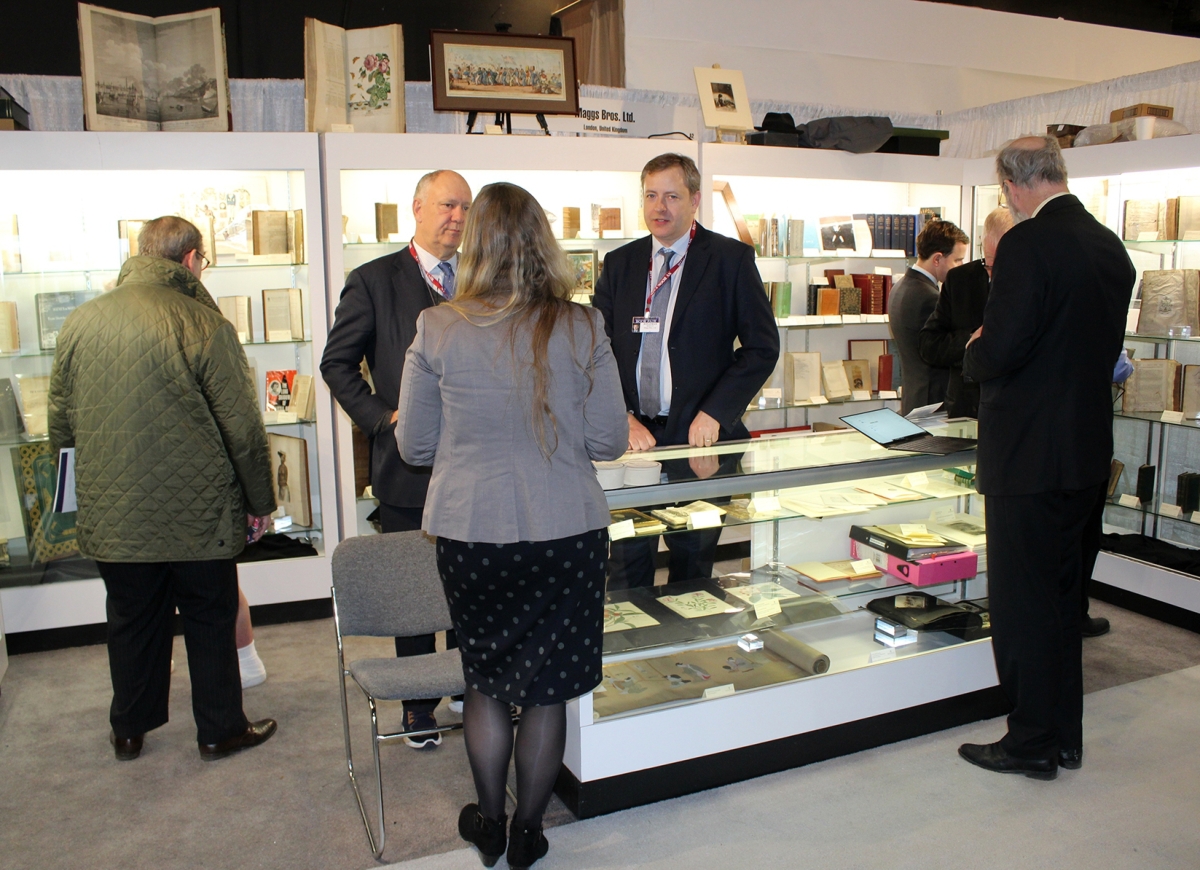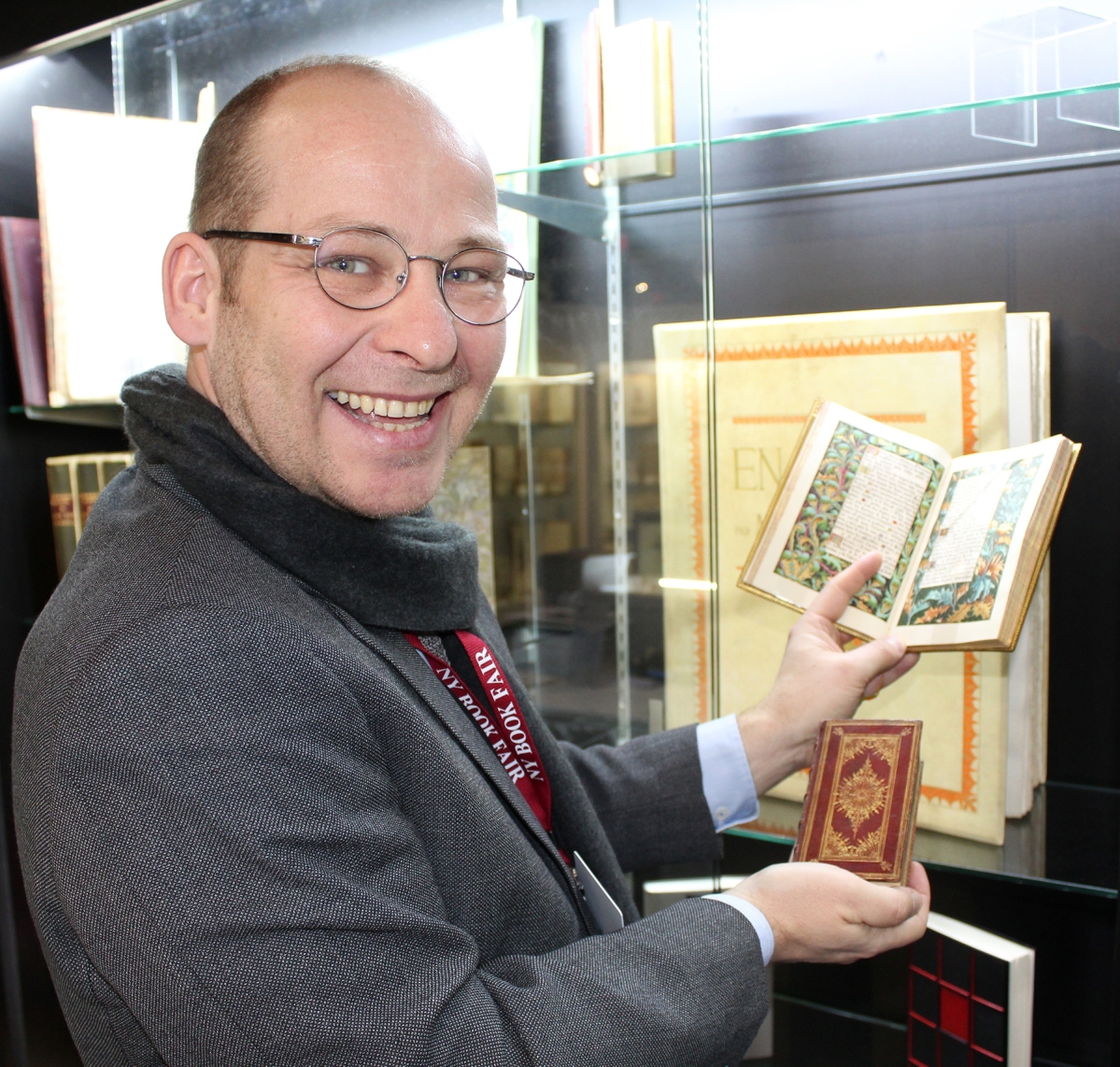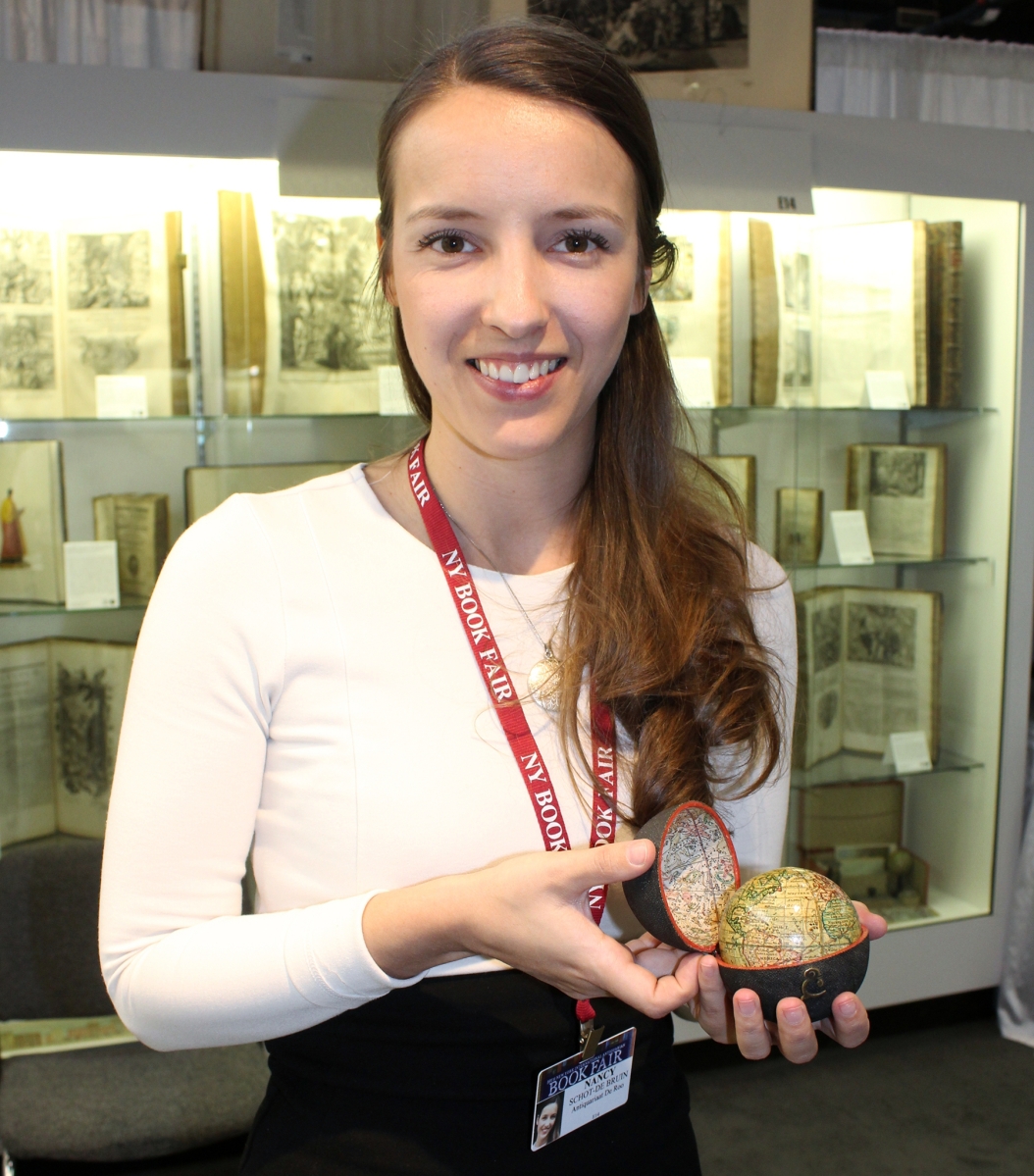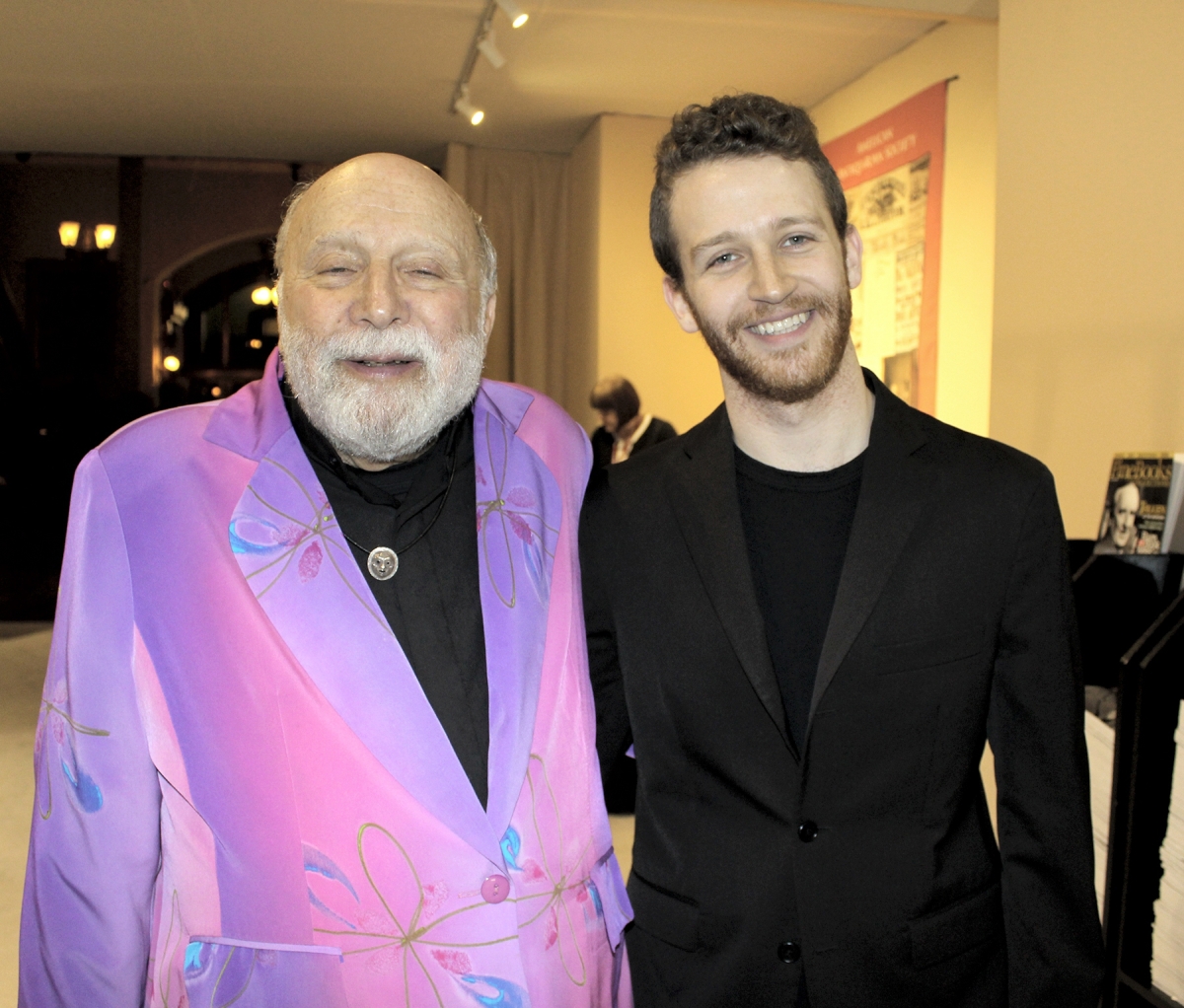
Show manager Sanford Smith and his son, Luc Bokor-Smith, freshly minted grad from Brown University who is forging his own creative path in electronic music and LED installations.
Review and Photos by W.A. Demers
NEW YORK CITY – The bard himself, who would be a spry 455 years old this month, would have approved of the venerable New York International Antiquarian Book Fair – present in effigy, perched on a stool at the show’s entrance at the Park Avenue Armory. And why not? The undisputed supreme playwright and poet of the English language would be quite at home at what is considered by many to be the best antiquarian book fair in the world.
Produced by Sanford L. Smith + Associates, this show was back for its 59th edition March 7-10. It reliably attracts both bibliomaniacs and seekers of the odd bit of ephemera, presenting a staggering treasure trove of material ranging from rare books, maps, illuminated manuscripts, incunabula, fine bindings, illustrations, historical documents and print ephemera.
Not only do seasoned museum curators, connoisseurs and scholars prowl the aisles for five- and six-figure gems, but the show increasingly brings in younger collectors who are able to find the beginnings of a collection at accessible price points. On opening night, a cadre of uniformed West Point cadets could be seen shopping the show, brought down for a special outing by one of their instructors.
Officially sanctioned by Antiquarian Booksellers’ Association of America and International League of Antiquarian Booksellers (ILAB), the show’s specialties – conveniently indexed in a comprehensive exhibitors directory – encompass art, science, medicine, literature, history, culinary culture, fashion, first editions, Americana, philosophy, children’s books and more. Historic scrolls, academic papers, religious tracts, illuminated manuscripts were presented alongside modern material culture artifacts like signed editions of How to Get Rich by Donald Trump and celebrity-signed electric guitars.
For its 59th year, the fair presented its largest roster of exhibitors – 213 dealers, 145 booths, according to the show’s chairman Donald Heald – from around the United States and the world. About half the dealers were from the United States but there was also strong representation from Canada, the United Kingdom, France, Germany, Italy, Japan, the Netherlands and other European countries.

Hordern House, Sydney, Australia, was spotlighting Sydney Parkinson’s book on Cook’s first voyage, with the double set of plates, black and white and color. The book, published in 1784, is famous for its wonderful illustrations that include a series of portraits of Maori New Zealanders, which are especially striking,
Returning here for his fifth year was Herve Valentin of Walden Rare Books, Orleans, France. Valentin is president of Syndicat National de la Librairie Ancienne et Moderne, the French arm of ILAB whose membership includes about 250 book, autograph and print dealers. Pointing out a couple of diminutive books in his showcase, both in Seventeenth Century fine bindings, Valentin said part of the reason he participates in shows like this and the Boston book fair is to “try to teach the ‘French taste.'”
An early sale at DeWolfe & Wood Rare Books, Alfred, Maine, was a broadside detailing the last will and testament of Sir Timothy Dexter (1747-1806), a Newburyport, Mass., businessman noted for his writing and eccentricity. “The Dexter broadside sold first thing opening night,” said Scott DeWolfe. “The show was very strong with remarkably big crowds all three days. The show attracts rare book librarians from around the country, and there seemed to be more than ever and they were buying.” DeWolfe said he sees the fair bucking the trend of many antiques and book fairs, with the number of visitors going up. “We are also seeing more young people at this show and many were buying. It is a very good trend.”
Adding to the show’s success, DeWolfe added, is having two “shadow shows” – Getman’s New York Book & Ephemera Fair and Flamingo Eventz’s Manhattan Vintage Book, Ephemera and Fine Press Fair [both reviewed separately in this issue – Ed.] going the same week. “It helps broaden the appeal with the combined dealers offering material from $10 to more than $1 million, so everyone can afford to go home with something. We sold books, broadsides, ephemera and even four Nineteenth Century soft paste children’s mugs that we took as decoration.”
Bart de Roo and his sister-in-law Nancy Schot were back again this year from the Netherlands with many Dutch rarities. One was a Seventeenth Century cadastral atlas, Landen van Voorne, a commission to the surveyor Heyman van Dijck to map the territory of Voorne (South Holland). Artist Romeyn de Hooghe was commissioned to decorate the maps, but executed just the title page, which the dealer had on view at his stand. Typical of de Hooghe’s work, the example was rich in allegorical imagery and coats-of-arms. Established in 2004 and specializing in old and rare books printed before 1800, bibles, theology, hand colored works and globes, both terrestrial and celestial, are all part of the mix at Antiquariaat de Roo. The dealer had both globes that were fixed to stands as well as some terrestrial pocket globes, which are popular among collectors. A circa 1775 example housed in the publisher’s shagreen case with two metal clasps had been updated with all the latest discoveries at the time, including depicting California correctly as a peninsula.
From Vienna, Austria, Michael Steinbach showcased his collection of rare art books and illustrated volumes. An emblematic book of the German Jugenstil, a 1900 title by Hugo von Vogeler-Hofmannsthal not only featured a title in vibrant gold, red, green, brown, violet and light blue, but its artistic design makes it one of the most desirable books of the early Twentieth Century. “The fair was well visited,” said Steinbach, “especially the first two days, there were many visitors and people interested in the books. I had the impression that most of the exhibitors were satisfied with the sales; for myself it was okay, maybe I would have liked to sell one of the highlights I had on offer.”
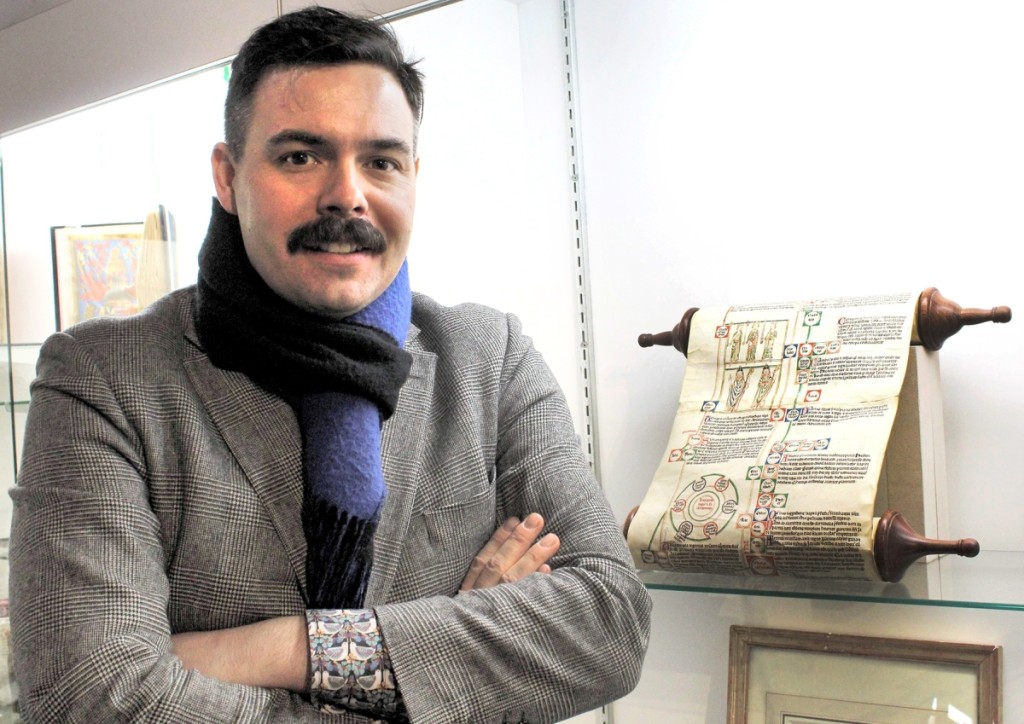
Les Enluminures vice president Keegan Goepfert stands next to a Thirteenth Century illustrated scroll summarizing biblical history from Adam to Christ. The last known example in private hands, it is 3 meters long when unfurled.
“It’s a wonderful opportunity to discover new material,” said James Roy, representing rare cartography and book dealer Martayan Lan, New York City. Roy said he has been with the firm for 19 years and has done this fair for 16 years. Although its specialty is maps ranging from the Fifteenth to the Twentieth Century, the firm also carries Americana, architecture and early printed books on medicine, science and travel.
Sandy Smith devoted a page up front in this year’s dealer directory to remember Bill Reese, founder of the William Reese Company of New Haven, Conn. Bill passed away in June 2018, but the company, now under the direction of Bill’s wife, Dorothy Hurt, continues its 40-year legacy as an important source of Americana and American art. Representing the company at the fair this year was Nick Aretakis, who said he rejoined the firm, coming back across the country from California to manage its Americana department. A Mexican incunable from 1554 with a six-figure price was one of the highlights on offer.
Les Enluminures, New York City, is known for all kinds of bibles, bindings and illuminated manuscripts. Featured at the show were examples from its inventory of Books of Hours, illuminated manuscripts, text manuscripts and miniatures; among the highlights, the Bybbesworth Hours, copies of Juvenal and Sallust, a Processional from Nonnberg Abbey (Maria’s convent in the Sound of Music) and a Thirteenth Century illustrated scroll summarizing biblical history from Adam to Christ. The last known example in private hands, it measures 3 meters long when unfurled. In Latin, the illuminated scroll on parchment was created circa 1230-50. Unlike scrolls of the ancient world that were designed to be read horizontally (such as the Jewish Torah), here the history since Creation tumbles down vertically. It was previously exhibited in the Metropolitan Museum of Art and was priced at $450,000.
That’s a lot of Barnes & Noble book credits. But the real buzz at the fair this year was over a French attic find being shown by Barry Lawrence Ruderman Antique Maps, Inc, La Jolla, Calif. Stickered at $1.5 million was a trove of 22 original blueprint drawings for the famed Statue of Liberty, an archive of drawings and blueprints from Ãtablissements Eiffel, 1880-83. “They were folded up at the bottom of a trunk and quite fragile,” said Alex Clausen, the firm’s director, who made the discovery within the past year. “We sent them to a paper conservator where they were carefully unfolded.”
Over in the booth of University Archives, Westport, Conn., dealer John Reznikoff had his own related highlight, an autograph letter signed by Frederic Auguste Bartholdi, French sculptor and designer of the statue. In a two-page bi-fold letter inscribed in French, Bartholdi pens from Paris on February 2, 1882, news of the statue’s work in progress to his friend and fellow Franco-American Union member Georges Glaenzer. Another rare find on offer here were two letters that had been penned by two brothers, Clarence and John Anglin, who were prisoners at Alcatraz in the 1950s, poignantly detailing prison life and inquiring about friends and family on the outside.

It just may be the most beautiful printed book in the English language. That was the unqualified opinion of Martin Weinkle, owner of Buddenbrooks, Newburyport and Boston, Mass. The volume he is holding is the 1896 Kelmscott Chaucer, created by William Morris and featuring the designs of Sir Edward Burne Jones. The cherry on top was its provenance, having been owned by George Abrams, the “Master of Typefaces.”
Just before preview opened, Arrosic, Maine, dealer James Arsenault was examining an early find he had made at the show. In the early Nineteenth Century, a Troy, N.Y., entrepreneur by the name of George Ketcham created advertising books featuring hotels, inns and other tourist establishments, utilizing original photos, postcards and even original hand illustration, ostensibly to be placed in the highly trafficked areas of such resorts. Arsenault obtained the unique and unrecorded book and was going to do some more research on Ketcham and his role as a pioneering adman.
Collectors could find an abundance of rare and unusual autograph and manuscript treasures at Lion Heart Autographs, New York City. Among the highlights here were scientific letters, including one by US astronaut Neil Armstrong referring to his moon flight just months after the Apollo XI crew returned to earth, plus a signed copy of his high school yearbook. There were also historical items, such as a marriage contract signed by Napoleon and Josephine and a rare handwritten letter by 15-year-old Catherine the Great; many musical autographs, including a signed photograph of George Gershwin. And one political item that surely generated gossip in its day. It was a presentation photograph, which, according to the firm’s David Lowenherz, had been given to Marguerite “Missy” LeHand (1898-1944), Franklin Delano Roosevelt’s private secretary, companion and possible mistress. The black and white photograph of the then governor and Mrs Roosevelt and 32 Democratic Party workers showed Eleanor off to the side and LeHand seated at FDR’s feet. The pewter frame was inscribed “M.A.L. From F.D.R., Feb. 5th, 1932.”
Martin Weinkle, owner of Buddenbrooks, Newburyport and Boston, Mass., had what he considered to be “the most beautiful printed book in the English language” – the 1896 Kelmscott Chaucer, created by William Morris and featuring the designs of Sir Edward Burne Jones. Mimicking the richness of Renaissance fonts and typographical design, the volume also had impeccable provenance, having been formerly owned by George Abrams, the “Master of Typefaces.”
Not everything is gold leaf, buttery binding and vellum at this show, as evidenced by a handful of plain typewritten manuscript raised aloft by Richard Meli, a Fort Lauderdale, Fla., dealer who specializes in modern fiction, mystery, science fiction and illustration art. Here was a typed manuscript by Conan creator Robert Ervin Howard (1906-1936), a friend of Robert Hayward Barlow (1918-1951), himself an American author, avant-garde poet, anthropologist and historian of early Mexico. Barlow, a closeted gay man, committed suicide in January 1951, fearing his homosexuality would be revealed by one of his students. This manuscript was inscribed “To R.H. Barlow with the best wishes of Robert E. Howard.”
Maritime history collectors, especially fans of American whaling lore, know to seek out Greg Gibson, proprietor of Ten Pound Island Book Co., Gloucester, Mass. Gibson was awash in nautical, naval, polar, Arctic, Antarctic and travel material, but one of the highlights was a whaling log that he described as a “greatest hits” diary of a whaleman. The author had illustrated only the most important encounters of an 1845-49 whaling expedition.

Created in the late 1940s, this set of bowling pins featuring the likenesses of Axis dictators Hitler, Mussolini and Hirohito was on offer by Battledore, Ltd/Justin Schiller, Kingston, N.Y.
Voyages also figure into a rare book being shown by Hordern House, Sydney, Australia. Spotlighting Sydney Parkinson’s book on Cook’s first voyage, with the double set of plates, black and white and color, the dealer’s director Derek McDonnell said the book, published in 1784, is “famous for its wonderful illustrations that include a series of portraits of Maori New Zealanders, which are especially striking,” McDonnell said he had a busy fair and was impressed by the level of interest in the material, much of which had to do with voyages discovery and exploration. “We are particularly specialized in the history of discovery in the ‘other’ ocean, the Pacific – which is one reason why we have usually done the California book fairs, for 30 years now,” he continued. “But the level of interest in New York means that we will hope to be back in future years. The armory is a wonderful venue.”
“There’s no serendipity on the internet,” explained the show’s chairman Donald Head, himself a 47-year veteran of the trade, when asked about the importance of such a gathering. And it’s true. How many times have you wandered through a public library, perhaps intent on finding something in particular but diverted by something compelling and new that catches your eye. Heald’s own booth was filled with a multitude of eye-catching material, ranging from a rare American work on dogs, with chromolithographed images after Alexander Pope Jr (1849-1924), to a copy of the deluxe hand colored edition of David Roberts’ monumental work on the Middle East to the second edition of the “most famous colorplate book of American plant and animal life, Mark Catesby’s (1683-1749) The Natural History of Carolina, Florida, and the Bahama Islands, a beautiful work by the founder of American ornithology.
Then there was what looked to be an inauspicious pile of buff-colored paper cutouts on a showcase shelf at Ursus Rare Books Ltd, New York City. What was it? We asked. Adam Gorfin, the firm’s owner, patiently explained that it was a Japanese architect’s unassembled model of a tea house, printed in the 1930s. It was a Zen kind of thing. “The show was okay for us sales-wise; however, as always, we bought quite well and saw a lot of good books on the floor,” he said. “It remains the best antiquarian book fair in the world.”
For information, 212-777-5218 or www.nybookfair.com.





